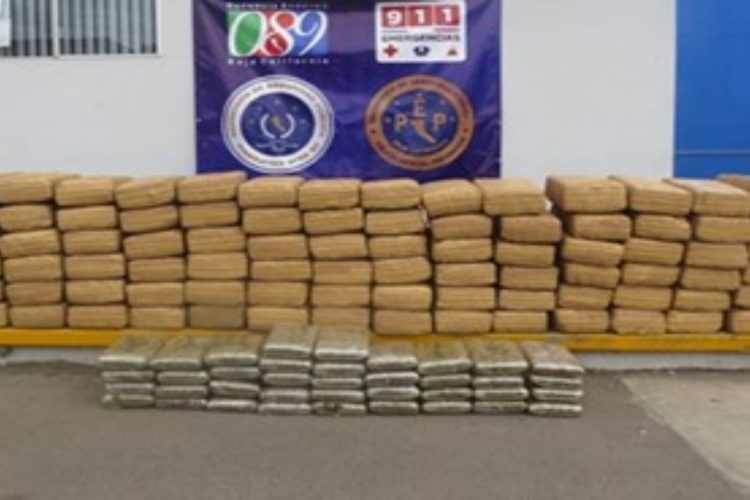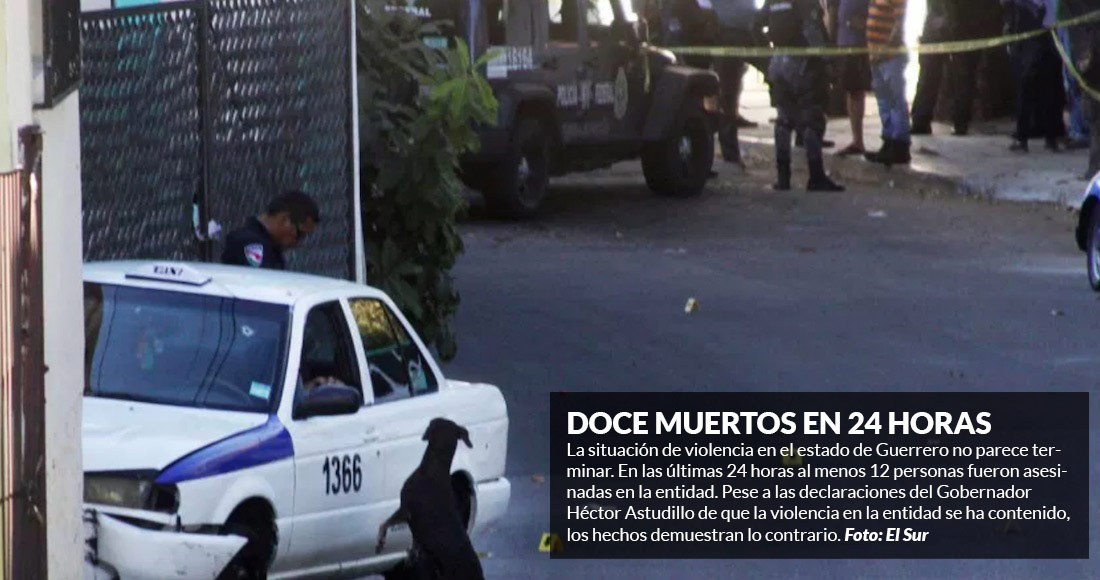Translated by El Profe for Borderland Beat from
Sin Embargo
![]() The situation of violence in the state of Guerrero does not seem to end. In the last 24 hours at least 12 people were killed in the entity.
The situation of violence in the state of Guerrero does not seem to end. In the last 24 hours at least 12 people were killed in the entity.
Acapulco, one of the state's most popular tourist destinations, daily records deaths, executions, kidnappings and more crimes, a situation that has made it one of the most violent municipalities in the country.
Despite the statements of Governor Hector Astudillo that the violence in the entity has been contained, the facts show otherwise. Guerrero / Mexico City February 16 (ElSur / SinEmbargo) - A new violent day yesterday left nine men and three women shot to death in different neighborhoods, in addition to the discovery of a human skull.
Also, two ‘’Acatianguis’’ [Acapulco outdoor market] stalls and one car were burned.
Yesterday, up to 9 o'clock at night, there were 49 victims so far this month, and it was the most violent day with 11 murders, according to a count from El Sur.
Also, a young woman who was with a group of motorcyclists attacked by gunfire last Sunday, near La Quebrada, died on Wednesday afternoon.
In a first violent incident yesterday, two women and two men were shot dead in the Rufo Figueroa neighborhood, in the vicinity of La Sabana.
The attack was reported at 4 in the morning, on Ciudad Perdida street and Iturbide, 500 meters from Lázaro Cárdenas Avenue, indicated in the ministerial report.
![]() |
Despite the operations implemented by the three levels of government, a wave of violence was recorded in less than 24 hours. Photo: Cuartoscuro |
The police version is that armed men shot at the four victims and then fled the scene.
The policemen, through an emergency call, found two women shot and killed and a man in the same state.
The wounded was transferred to a nearby hospital, but later died from bullet wounds. Experts from the Acapulco Regional Prosecutor's Office located several scattered shells in the road at the crime scene.
The women were close to the scene and apparently were sitting there when they were shot, while the men were about five meters away from them because they apparently tried to flee their assailants, the police said.
In the afternoon, a taxi driver and a woman, apparently his partner, were riddled inside a blue and white public service vehicle in the Mozimba subdivision, located on the west side.
The double crime occurred at 4 pm on Granjas Avenue, about 150 meters from the Pie de la Cuesta road, indicated in the police report.
Witnesses told the policemen that armed men in a car chased their victims shooting at them, who were in the taxi, in order to kill them.
It was detailed that the taxi driver hit the wall of a house. The experts located several scattered shells in the area. The bodies were transferred by strangers to the facilities of Semefo.
Before, two men were shot to death in an orchard of San Isidro Gallinero, located in the rural area.
The double finding was reported at 1 o'clock in the afternoon in a produce farm located on the main road that connects to El Salto, indicated in the report of the State Police.
The agents by means of an emergency call found two men shot and bound by their hands.
The police version is that armed men took their victims and then moved them to a less crowded place and they were shot in the head.
The bodies were found about 20 centimeters away and at first sight they had shots in the head, the experts reported.
The first victim wore only a pair of jeans and the second a gray pair of shorts.
During the proceedings the ministerial police located two shells fired by a super 38 caliber weapon. The Public Ministry of El Coloso initiated an investigation file for the double crime.
Minutes later, a man was gunned down inside a taxi site on busy Cuauhtémoc Avenue.
The crime was reported at 2 in the afternoon, near the Bicentennial Bridge, in the Magallanes subdivision.
The police version is that armed men broke into the site of the taxis on the Acapulco-Ayutla route, and fired without saying a word against anyone.
In spite of the violent incidents, the other taxi drivers of the site remained in the area. The violent act caused a strong police deployment of the three orders of government. The victim was sent to Semefo.
In the morning, a semi-naked man was found shot and killed inside a car in the town of San Isidro Labrador, in the west.
The finding was reported at 10 in the morning, near the Acapulco-Zihuatanejo highway, ahead of Pie de la Cuesta.
The agents there found a white Chevy abandoned near the federal highway.
During review of the scene, experts located the victim in the truck of the car, about 50 years old, shot to death. The relatives went to the scene of the crime.
And at night, a cargo truck driver was shot to death and another man was injured in the town of Metlapil, in the rural area.
The violent incident was reported at 8 pm at the gas station located on the Acapulco-Pinotepa Nacional highway, near the Diamante Viaduct, indicated in the police file.
The police version is that armed men shot at the victim, who was inside the Dina cargo truck, but it is not clear what it was transporting.
The injured was identified as José Luis, 54, from Uruapan, Michoacán, and was attended to by paramedics from the Red Cross.
And a young man, presumably the son of a commander of the Ministerial Police, was shot to death in Renaissance City.
The homicide was reported at 9 o'clock at night in the Villa Sol housing complex, indicating the file of the State Police.
The officers found a young man in his 20s, apparently the son of a commander of the Ministerial Police, shot dead, without giving further details of the victim.
The police authorities found several shells struck by a .9 millimeter caliber weapon.
So far this month there are 50 victims and in the year there are 129 homicides, allegedly related to organized crime, according to a count from
El Sur.
In addition, a human skull was found in a garbage container in the El Coloso housing unit.
The finding was reported in the first minutes of Thursday on the Cayaco-Puerto Marques highway, near the Technological Institute of Acapulco, indicated in the report of the State Police.
The agents by means of an emergency call found the human skull inside a garbage container, so it was transferred to the Semefo.
In another case, two semi-fixed stands were set on fire at the Acatianguis, located next to the Comercial Mexicana de la Zapata store.
According to the police report, the fire started at 7 in the morning and was intentionally started.
According to witnesses, unknown people sprayed gasoline at the blacksmith stands and then set them on fire.
Municipal firefighters controlled the fire that affected tables in both locations.
Last Wednesday, four semi-fixed stalls were burned in the same area of Acapulco, on Vicente Guerrero boulevard, in Renacimiento City.
A car was set on fire in the Fovissste housing unit.
The accident was reported at 5 pm between Del Maestro Avenue and Rinconada Street, firefighters reported.
Witnesses told the cops that unknown people sprayed gasoline on the blue Tsuru car, which was parked, and then set it on fire.
The firefighters put out the car's fire, where a narcomanta was placed whose content is unknown.
The fire and smoke that the car gave off caused astonishment among the neighbors who looked from their apartments.
And last Wednesday a young woman from the group of motorcyclists shot dead Sunday at La Quebrada, where seven people were injured, died at the hospital.
The death was reported in the General Hospital of El Quemado, indicated in the ministerial report.
The victim was named Yukari, 20, who received several bullets in the abdomen, according to the medical report.
On Monday, two of the injured in that attack were discharged from the hospital and there are only four internees in different hospitals.
The injured are Eder, 25; Graciela, 20 years old; Kevin, 23 and Anthony, 21.





















